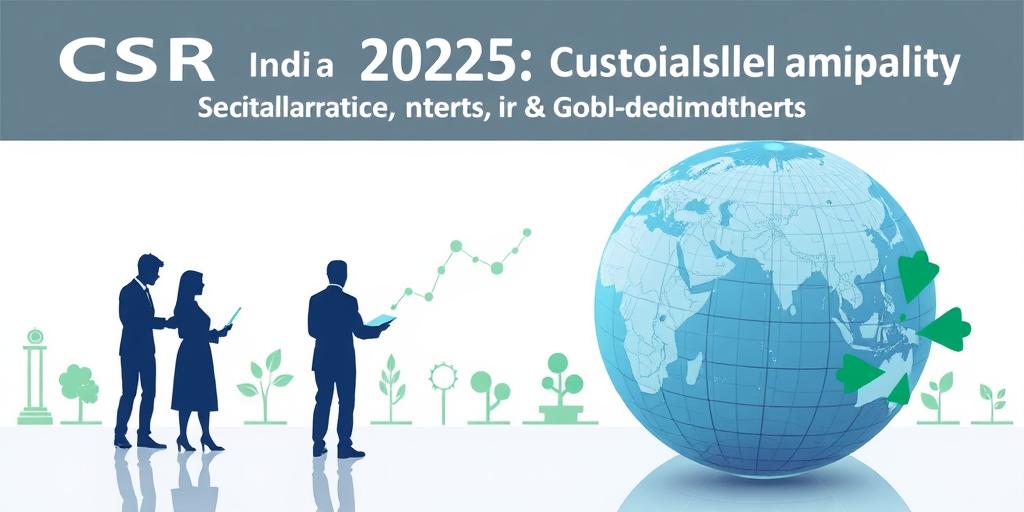Corporate Social Responsibility (CSR) in 2025: India & Global Standards
Corporate Social Responsibility (CSR) has evolved from a philanthropic activity to an integral part of business strategy. As we approach 2025, it’s crucial to understand the evolving landscape of CSR, particularly in India and within the context of global standards. This post provides an informative overview of what to expect.
What is Corporate Social Responsibility (CSR)?
CSR refers to a company’s commitment to operate in an ethical and sustainable manner, taking into account its impact on the environment, society, and economy. It extends beyond legal obligations, reflecting a company’s dedication to contributing positively to the world.
Key Trends Shaping CSR in 2025
Several key trends are expected to shape the future of CSR:
- Increased Transparency and Accountability: Stakeholders are demanding greater transparency in CSR reporting. Companies will need to provide detailed information about their CSR initiatives, including measurable outcomes and impacts.
- Integration of ESG Factors: Environmental, Social, and Governance (ESG) factors will be further integrated into CSR strategies. Investors and consumers are increasingly using ESG metrics to assess a company’s performance and make informed decisions.
- Focus on Sustainable Development Goals (SDGs): The United Nations’ SDGs will continue to be a guiding framework for CSR initiatives. Companies will align their CSR programs with specific SDGs to address global challenges such as poverty, inequality, and climate change.
- Technological Advancements: Technology will play a significant role in enhancing the effectiveness of CSR programs. Data analytics, artificial intelligence, and blockchain can be used to track progress, improve transparency, and engage stakeholders.
CSR in India: A Unique Landscape
India has a unique CSR framework, mandated by Section 135 of the Companies Act, 2013. This law requires companies meeting certain financial thresholds to spend 2% of their average net profit on CSR activities. Key aspects of CSR in India include:
- Mandatory Spending: The 2% spending rule has led to a significant increase in CSR investments in India. However, the focus is shifting towards ensuring the quality and impact of these investments.
- Priority Areas: The Indian government has identified priority areas for CSR spending, including education, healthcare, environmental sustainability, and rural development.
- Local Focus: Companies are encouraged to focus their CSR activities in local communities where they operate, addressing the specific needs and challenges of those areas.
Global CSR Standards
Several global standards and frameworks guide CSR practices worldwide:
- Global Reporting Initiative (GRI): GRI provides a comprehensive framework for sustainability reporting, enabling companies to disclose their environmental, social, and economic impacts.
- UN Global Compact: The UN Global Compact is a voluntary initiative that encourages companies to align their operations and strategies with ten universal principles in the areas of human rights, labor, environment, and anti-corruption.
- ISO 26000: ISO 26000 provides guidance on social responsibility, helping organizations integrate ethical and sustainable practices into their operations.
- Sustainability Accounting Standards Board (SASB): SASB focuses on financially material sustainability information, enabling investors to assess the sustainability performance of companies.
Preparing for CSR in 2025
To effectively navigate the evolving CSR landscape, companies should:
- Develop a comprehensive CSR strategy: Align CSR initiatives with business goals and stakeholder expectations.
- Integrate ESG factors: Incorporate ESG considerations into decision-making processes.
- Enhance transparency and reporting: Disclose CSR performance using recognized frameworks such as GRI and SASB.
- Leverage technology: Use data analytics and other technologies to improve the effectiveness of CSR programs.
- Engage stakeholders: Collaborate with employees, customers, suppliers, and communities to create shared value.
Conclusion
As we move closer to 2025, Corporate Social Responsibility will continue to be a critical aspect of business operations. By understanding the key trends, adhering to global standards, and focusing on impactful initiatives, companies can create positive change and contribute to a more sustainable future. In India, the unique regulatory framework adds another layer of complexity, requiring companies to strategically align their CSR spending with national priorities and local needs.
